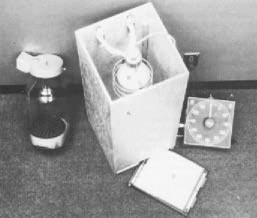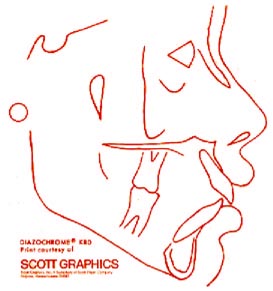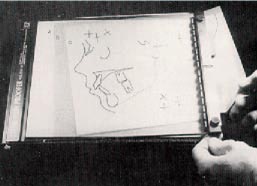Full-Scale Color Transparencies of Cephalometric Tracings
The purpose of this article is to describe how to prepare full-scale color transparencies of cephalometric tracings. A cropped version of an actual film is bound with this article.
The Film
The film, Tecnifax Diazochrome®, costs 31 per 8½" X 11" sheet and is available in ten different colors (from Scott Graphics, Inc., Holyoke, Mass. 01040). It can be handled for brief periods in incandescent and fluorescent light. Sunlight must be avoided because the dye is bleached from the film by ultraviolet radiation.
The Apparatus
Figure 1 shows the equipment used by the author. The exposure box is 3/8" plywood, 30'' high X 12" wide X 13" deep, open at the top and across the bottom of the front. The light source is a 275-watt sunlamp. The timer was added for convenience. A photographic proof printer is used to hold the film and tracing in tight contact during exposure. After exposure the film is developed in the spring-top glass jar (also available from Scott Graphics). A large restaurant-size pickle jar containing a sponge covered with a rubber drain mat would work equally well. The sponge is saturated with 58% (26° Baume) aqueous ammonia. If the jar is kept tightly closed when not in use, weekly replenishment of the ammonia is sufficient.
The Process
A cephalometric tracing is made in the conventional manner on acetate film, using a lead pencil. The cephalogram is removed and the tracing taped on a view box. Using a Koh-I-Noor Acetograph Pen (Koh-I-Noor, Inc., Bloomsbury, New Jersey 08804), all pencil lines are darkened with black opaque drawing ink. Lettering is applied by using a typewriter or pressure sensitive drafting symbols which can be purchased in sheets from a drafting supply store.
A sheet of unexposed diazo film is placed on the stage of the proof printer; on top of this is placed the acetate tracing inked side down (Fig. 3). The proof printer is closed and placed in the exposure box. The sunlamp is turned on. Exposure time varies depending on the color of the film. With the apparatus described, 5 to 7 minutes are required to render a sharp image against a color-free background. The image is revealed by placing the exposed film in the ammonia jar for approximately 2 to 3 minutes.
The film remains dry throughout the process, and is available for immediate use upon removal. Unlike a conventional acetate tracing, the lines are smudge-free and the background is clear and colorless, thus allowing superimposition of many films without loss of detail. The transparency can
be kept in the patient's folder or mounted in a cardboard frame for presentation at the view box or projection to a group.





